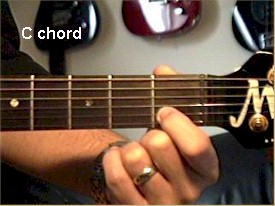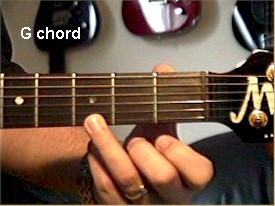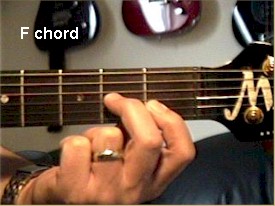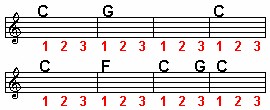Scroll through the lesson and click on notation/video/audio links to load the interactive players.
Please subscribe to get full access to all lessons for only $7.95/month PLUS 1 week free trial.

Riff Interactive lessons are
LESS expensive and
MORE interactive than alternatives!
More Info
|
|

Beginning
Guitar II - Lesson 2
Playing A Song
Lyle: Welcome back! Last lesson was a long and tough lesson where you learned all the name
of the notes and fingering patterns. This lesson will teach you a simple song
using three chords.
Lyle: The song you're going to learn is the
"Happy Birthday" song! It uses three chords, the C chord you learned from an
earlier lesson:
C
chord

C chord
Lyle:
The simple G chord you also learned from an earlier
lesson:
G
chord

G chord
Lyle: The third chord you need to learn for this
song is the F chord. You have to use your index finger to push down on both the
1st and 2nd strings at the same time. This is called barring:
F chord

F chord
David: Does it
matter where the other fingers are?
Lyle: David, yes it does. Keep them relaxed and
out of the way. Remember, these are the simple ways to play
these chords. Later, in future lessons, you'll learn many other ways to play
these chords.
Izabella: Can we play the whole chords (typical open
ones) or does it sound better with these easy 3 string
ones?
Lyle: If you know other ways to play them,
sure!
Lyle: Let's learn how to play the song. Here is
"the band" that you'll be jamming along to. It's a looping jam track. Load it
now and listen to it:
Jam Track - full song
Lyle: This song, Happy Birthday, is in what's
called 3/4 time. It has 3 beats per measure.
You only count to 3, not 4 like in most music.
Joel:
it's like a waltz, isn't it Lyle? :)
Lyle: Joel, yes, a Waltz is 3 beats per
measure.Lyle: Here is the chord chart which helps show
you how to count and when to change
chords:
chord
chart

Izabella: What advantages does it have over just putting
a bunch of dotted half notes or
something
Lyle: It would look messy on paper that
way.
Izabella: I
see.
Lyle:
First, try strumming on beat 1 of every measure, like
this:
rhythm
pattern 1
rhythm pattern
1
Lyle:
Every beginning guitarist should know how to strum and sing this song. You'll
always find a chance to use it on
someone!
Lyle: I bet it's someone's birthday
today!
Lyle: How's everyone doing with it, are you able
to follow along and make the chord changes at the right
time?
willie:
working on it...
Lyle:
Once you have a good feel for that rhythm pattern, I want you to try strumming
on every beat of the measure like this:
rhythm pattern 2
rhythm pattern
2
Lyle:
That's how I would strum it, once for each beat, because it creates a strong
pulse/beat that everyone can follow when they are all singing
along.
Lyle: If you are new to this lesson format and
software, be sure to click on the TAB file so it loads into the TAB player, then
load media, then play media. This way you'll see and hear it playback on the
virtual fretboard. You can loop the TAB files and even slow
them down. You can even slow down the tempo of the looping jam track if
needed.
Lyle: Practice singing along to the jam track
while you're strumming too!
Lyle: The whole melody is made from the natural
notes, like you learned in the last lesson. Here's the natural notes again, from
A to A to A:
natural notes from A to A
Lyle:
Just for fun, you should try learning how to play the melody of this song. It's
best to learn it it small sections. Here's the first
part:
song - part
1
Lyle: If
you're using a pick, use all down
strokes.
Lyle: Practice this over and over until you can
play it good and from memory, then learn the next part:
song - part
2
Lyle:
The next part involves three different strings which should give you a nice
little challenge!
Izabella: Why all down strokes?
song -
part 3
Lyle:
Keeps it uniform sounding, and since it's so slow, it's easy to play all
down.
Lyle:
The 4th part is simply this:
song - part 4
Lyle:
Put all the 4 parts together and you have the whole song!
song - all 4
parts
song - all 4
parts
Lyle:
Play along to the TAB file to make sure you have all the right notes and
fingers. For the melody of this song, anything on the 1st fret will be played
with the index finger, anything on the 2nd fret will be played with the middle
finger, and the 3rd fret note will be played with your ring finger. The
fingerings show up on the virtual fretboard when you playback the TAB
file.
Lyle: Once you have practiced the melody and
strumming parts enough, try playing along to the looping jam track. You've just
learned another song!!!
Izabella: Any hints for
embellishments?
Lyle: I could teach you a jazz version, a rock
version, and a country version of this song, but they're not easy to play. Maybe
in a custom private lesson I could show you if you
wanted.
Lyle: That wraps it up for this
lesson.
David:
Thanks a lot mate for your time..appreciated. Bye.
Lyle: You're all very welcome.
Thank you everyone for joining us live for this lesson. I hope you all have a
great week playing and practicing your guitar. See you in the next lesson!
|
<< load notation from left
|
|
<< load audio from left
|
<< load audio from left
|